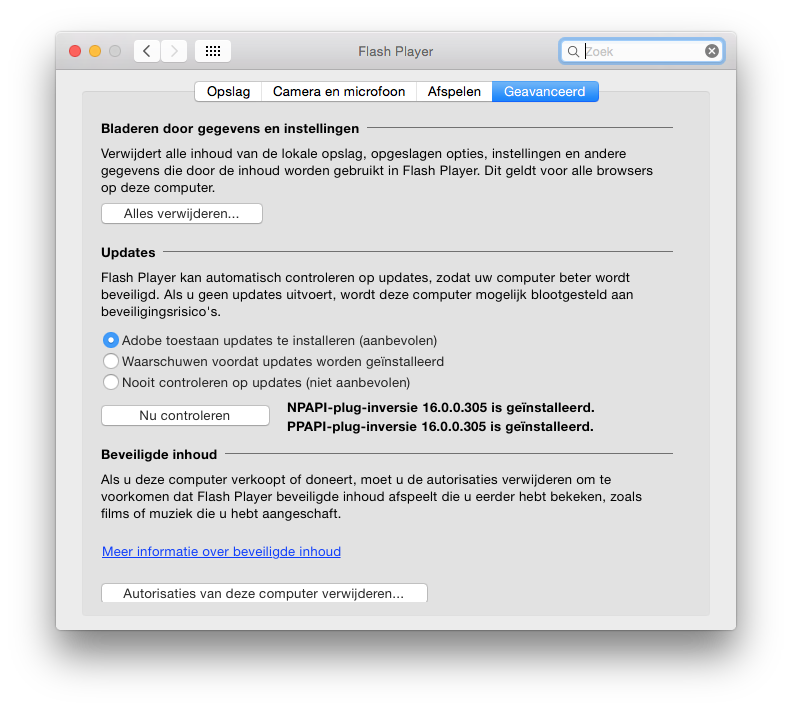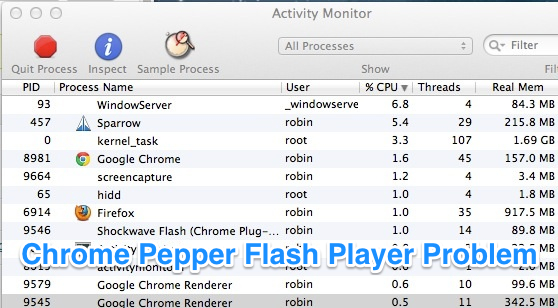Pepper Flash Player Mac

If you're adding a new API, see Pepper API Best Practices for helpful guidelines and our process is documented in Pepper API Proposals.
In the Flash section there should be 2 or 3 different versions of Flash listed. If the Flash section only has one Flash file listed, Click Here to go to the Adobe website and download and install the Adobe Flash Plugin for Non-Internet Explorer browsers. The first Plugin listed in the Flash. Pepper Flash Player Plugin Mac Download Full Fix for MySpeed for Windows v3: Upgrade to MySpeed v5 or disable PepperFlash. To use the Pepper Flash plugin in Electron, you should manually specify the location of the Pepper Flash plugin and then enable it in your application. Jul 30, 2013 Google Chrome has Adobe Flash Player installed by default in its browser software and Pepper Flash Player is an extension for Mac OS X computers that manages flash contents. There are multiple versions of flash extensions running to manage the flash contents you view on the web. Watch video Pepper Hart Fucks Mandongo's Black Cock on Redtube, home of free Blowjob porn videos and Redhead sex movies online. Video length: (12:38) - Uploaded by Dogfart Network - Starring Pornstars: Mandingo, Pepper Hart.
Quick reference to important code locations
- ppapi — Root PPAPI code.
- api — IDL versions of the interfaces.
- c — Public C binary interface (generated by the IDL, checked into the tree)
- cpp — Convenience C++ wrapper around the C interface.
- generators — the IDL-to-C compiler
- host — code used in content and chrome to implement the backends for the various resources.
- native_client — The NaCl trusted plugin
- proxy — Chrome IPC-based proxy
- tests — Source code for the unit tests.
- shared_impl — Contains implementations for Pepper objects that we want to share between the proxied (ppapi/proxy) and the in-process version (content/renderer/pepper).
- thunk — Converts the C PPAPI calls from the plugin into C++ for the browser implementation.
- chrome/browser/renderer_host/pepper/pepper_*_host.* — Backend ('host') implementations of new-style resources in the Chrome browser process.
- chrome/renderer/pepper/pepper_*_host.* — Backend ('host') implementations of new-style resources in the Chrome renderer process.
- content/renderer/pepper/ppb_*_impl.* — Implementation of the old-style in-process resources and their connection to WebKit.
- content/browser/renderer_host/pepper/pepper_*_host.* — Backend ('host') implementations of new-style resources in the Content browser process.
- content/renderer/pepper/pepper_*_host.* — Backend ('host') implementations of new-style resources in Content renderer process
- content/renderer/pepper/pepper_plugin_delegate_impl.* — Delegate interface used to talk to the browser from the WebKit code.
- content/renderer/render_view.cc — Allocates the plugins (see createPlugin).
- chrome/test/ppapi/ — Code to run the tests as part of the Chrome browser tests.
Issue tracking
- Area-Internals
- Cr-Internals-Plugins-Pepper

- NaCl
Running a plugin in Chrome
'Old' resource and proxy design
- Plugin calls PPAPI function.
- Thunk layer converts this to a C++ call on a resource object.
- Resource object sends IPC message to renderer via the PluginDispatcher.
- The HostDispatcher receives message and forwards it to the appropriate interface proxy object in the renderer.
- Interface proxy converts IPC message back to a PPAPI call and issues it to the in-process implementation.
- Resource 'impl' gets call and performs action.
'New' resource and proxy design
- content/renderer/pepper/ — Probably the most common location. Most resources that interact with blink or other renderer functionality will go here.
- chrome/renderer/pepper/ — Use for Chrome-only interfaces (Flash, PDF, other custom stuff for custom Google plugins).
- content/browser/renderer_host/pepper/ — Use instead of or in addition to content/renderer/pepper when your resource needs to talk to the browser process for some reason.
- chrome/browser/renderer_host/pepper/ — Use instead of or in addition to chrome/renderer/pepper when your resource needs to talk to the browser process for some reason.
- Plugin calls PPAPI function.
- Thunk layer converts this to a C++ call on the proxy resource object.
- Proxy resource does a CallRenderer with its message. This gets embedded into a 'resource call' IPC message which encodes the resource ID and instance.
- The ResourceHost in the renderer receives the message and finds the corresponding resource host object.
- The resource host decodes the message and performs the operation.
Adding a new interface
- Create the IDL file.Most new interfaces will be dev so would be called ppapi/api/dev/ppb_foo_dev.idl.
- Generate the C interface file. Run the script ppapi/generators/generator.py. Make sure to run it from within the generators directory. This should make a corresponding ppapi/c/dev/ppb_foo_dev.h file which you should add to your CL.
- Write a C++ wrapper for your interface. (Some classes may not need C++ wrappers, check with Brett if you're unsure.) The corresponding location would be in ppapi/cpp/foo_dev.h. This is pretty easy and you should be able to copy the surrounding classes. Add it to the .gyp file.
- Add your new interface file to the C test list inppapi/tests/all_c_includes.h. This is how we make sure that everything continues to compile in C (rather than just C++ mode).
Pepper Flash Player Mac
(this is the same between the 'new' and 'old' proxy designs):Pepper Flash Player Download
- Write a C++ 'API' for it. This is in ppapi/thunk/ppb_foo_api.h. This defines the virtual interface that Chrome will use to implement your interface. If your interface is a bunch of functions rather than a new resource, you can just add it on to ppb_instance_api.h. Check with Brett if you're unsure. Add a creation function for your resource to ResourceCreationAPI.
- Write a thunk for it. This converts the C PPAPI calls for your interface to C++ calls on the API you made in the previous step. Look at a similar interface to see what it does. Typically the Create function on a resource API would go through the ResourceCreationAPI object (add a function there for your new resource type) and the rest of the functions go through to your API. Add the thunk and API to ./ppapi/ppapi_shared.gypi.
- Register the interface with Chrome. Add it to ppapi/thunk/interfaces_ppb_public_dev.h. Follow the directions in the _stable version of that file. This tells Chrome about your interface name and connects your thunk function to it. This file is included in various places that define implementations of the macros to register the name->vtable mapping.
- Create the proxy file. This is called FooResource as opposed to 'old' design resources which would be PPB_Foo_Proxy.
- Define the IPC messages you need. Add them to ppapi/proxy/ppapi_messages.h. You'll generally need one for creating your host resource, one for each 'call' from the proxy to the host, and one for each 'reply'.
- Write a unit test in the same directory. This should just emulate the IPC layer. Be sure to test different edge conditions and make sure that the proper IPC messages are sent in response to plugin calls, and that the correct plugin callbacks are called in response to IPC messages.
- Write the resource host. Put the file in one of the four locations discussed above.
- Hook up the host creation. The host factory in the same directory as your resource host should have a switch in it. Be sure to check the permissions if your interface is dev/trusted/etc. to make sure the plugin is allowed to create such resources.
- Implement the IPC message handlers. You should be able to copy how an existing resource host works to get the calls you expect.
- Keep in mind that the plugin is untrusted. It could be trying to exploit you. Don't trust that it has permission to do anything, and rigorously check all parameters.
Designing your interface
- The first two functions in a resource's interface should be PP_Resource Create(PP_Instance, ...) to allow creation of your resource and PP_Bool IsFoo(PP_Resource) to allow for type checking.
- Since most stuff happens out-of-process, these functions should be asynchronous. Asynchronous functions should take a PP_CompletionCallback argument and return an int32_t (which will normally be PP_OK_COMPLETIONPENDING for asynchronous completion). It's important that your create function not be asynchronous because then the caller has no way to cancel the callback (normally you can just delete the object). If you object constuction requires asynchronous completion, have a simple synchronous Create function and then an asynchronous Open or Init function which you would call after creation.
- Many completion callbacks want to return data. These should be of the form:
int32_t DoFoo(PP_Resource resource, PP_Var* output_arg, PP_CompletionCallback cb);
Your C++ wrapper can then take a CompletionCallbackWithOutput<Var> which has template magic to convert the output argument to a parameter on the callback function.
Writing error logs
- Log messages should have the name of the interface, a dot, and the function name, followed by a colon and the text of the message. The rest of the message should begin with a capital and end with a period as with Chrome comments. So: 'PPB_Foo.Frobulate: The bar is invalid.'.
- Not all errors should have error logs. In fact, most shouldn't. Most functions should have well-defined error conditions that are described in the documentation for that function. In this case, it's unnecessary to log an error because the caller can easily see they got a NOACCESS and look up what that means in the context of your function, for example.
- Some things may be tricky or easily called incorrectly, may have no return value, or ambiguous return values. In these cases, it can be useful to add a Log call to tell the programmer how they messed up.
Architecture of the renderer implementation
- To WebKit, a Pepper plugin is the same as an NPAPI plugin. We implement the WebKit::WebPlugin interface as webkit::ppapi::WebPluginImpl in ppapi_webplugin_impl.cc. This is our analog of NPAPI's webkit::npapi::WebPluginImpl.
- The PluginInstance object talks to the plugin's PPP_Instance interface, and receives requests through the browser's PPB_Instance interface.
- The PluginInstance owns a reference to the PluginModule which represents the shared library loaded in the renderer. The PluginModule is shared between all instances of that plugin. It handles loading and unloading of the library, implements the PPB_Core interface, and also implements the GetInterface function that the plugin module uses to get all other browser interfaces.
- In some cases, the plugin needs to talk 'up' the browser stack. For example, a certain operation might require that the browser process do something on behalf of the plugin. To support this, there is the webkit::ppapi::PluginDelegate virtual interface.
- The RenderView handles creation of the Pepper plugin in RenderView::createPlugin. RenderView has as a member a helper class PepperPluginDelegateImpl which implements the webkit::ppapi::PluginDelegate interface. This implementation is supplied to a plugin when it is created.
Debugging a plugin
Running the tests

Install Adobe Pepper Flash Player Mac
Running HTTP tests manually

Running NaCl tests manually
Download Pepper Flash
set PYTHONPATH=third_partypyftpdlibsrc;third_partytlslite;third_partypywebsocketsrc
python nettoolstestservertestserver.py --port=1337 --data-dir=out/Debug
